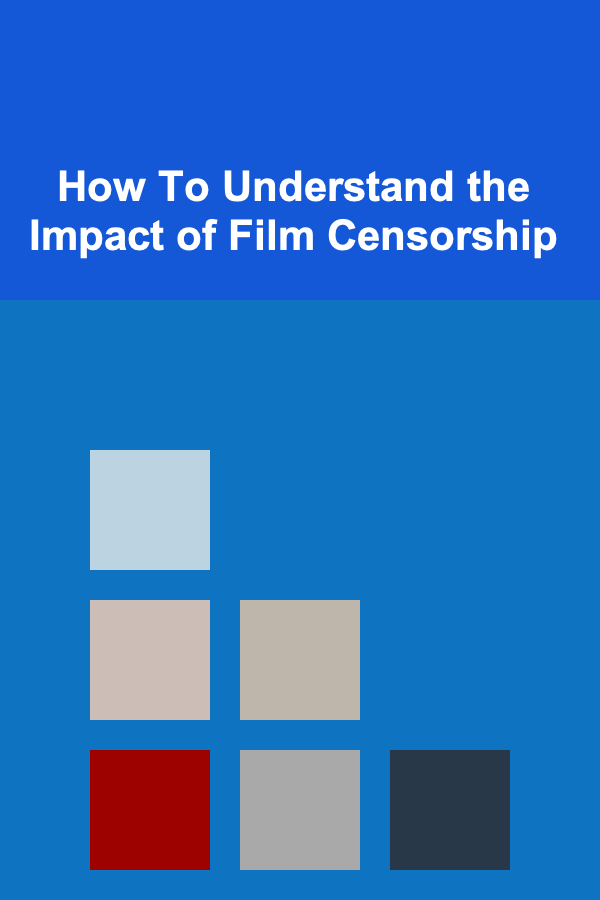
How To Understand the Impact of Film Censorship
ebook include PDF & Audio bundle (Micro Guide)
$12.99$11.99
Limited Time Offer! Order within the next:

Film censorship is a critical issue in the global film industry that involves the restriction or regulation of certain content in films to protect the interests of governments, social norms, or other groups. While it often aims to prevent the dissemination of offensive, harmful, or controversial material, the consequences of film censorship can be both profound and far-reaching. The impact of censorship can touch on various aspects of cinema, from creative expression and artistic freedom to public perception and cultural understanding.
This article explores the complex impact of film censorship, its historical roots, the various forms it takes, its influence on filmmakers and audiences, and the ethical dilemmas it raises. Additionally, we will examine the role censorship plays in shaping the content of films and its broader implications on society, politics, and culture.
The Historical Context of Film Censorship
The practice of censoring films has deep historical roots that go back to the early days of cinema. As motion pictures became more popular, governments and social groups started to take an interest in controlling what was presented on screen. The rise of film censorship was influenced by societal values, political agendas, and cultural concerns, with authorities often fearing the power of cinema to sway public opinion, incite unrest, or corrupt moral values.
Early Years of Film Censorship
In the early 20th century, films were often seen as a disruptive force in society, particularly by conservative governments and religious groups. These groups argued that films had the potential to promote immoral behavior, especially with the rise of Hollywood films that depicted themes of sexuality, crime, and violence. In response to these concerns, film censorship began to take shape in various countries.
For example, in the United States, the Hays Code (officially known as the Motion Picture Production Code) was introduced in 1930 as a self-regulation measure by the film industry. The Hays Code banned the depiction of certain content, such as sexual innuendos, explicit violence, and immoral actions, in films. This code had a profound impact on the type of content produced during its enforcement, shaping the landscape of American cinema for over three decades.
Global Censorship Movements
The impact of censorship was not confined to the United States. Countries around the world have established their own censorship systems to control the content of films, often with political and cultural motivations. In totalitarian regimes, censorship is used as a tool for maintaining control over public discourse, while in democratic societies, censorship laws are often aimed at balancing freedom of expression with the protection of societal norms.
In countries like China, film censorship is particularly strict, with films being subject to review and approval by government bodies before they can be shown to the public. Similarly, the Middle East, including countries like Saudi Arabia and Iran, has some of the most rigorous censorship practices in place, often in the name of protecting religious and cultural values.
Forms of Film Censorship
Censorship in films can take many forms, each affecting different aspects of the film and the content presented to the audience. Some forms of censorship involve the removal or alteration of scenes, while others focus on the banning of entire films or limiting access to specific audiences.
Content Editing and Scene Removal
One of the most common forms of film censorship is content editing, where certain scenes or elements of a film are either removed or altered to fit the standards of the censoring authority. These edits often target specific elements of a film that are deemed inappropriate, such as graphic violence, nudity, profanity, or political themes.
For example, in films like The Godfather, certain violent scenes were heavily edited to reduce their intensity, and in many cases, specific words or phrases were altered or removed to meet cultural sensitivities.
Film Bans and Prohibitions
In some cases, films are banned entirely by government bodies or film boards, often due to their perceived threats to national security, political stability, or social harmony. Bans can be placed on films that depict sensitive political issues, controversial historical events, or challenge traditional cultural or moral norms.
A notable example of this form of censorship is the banning of A Clockwork Orange in several countries. The film was seen as promoting violence and lawlessness, and it faced widespread censorship and prohibitions from various authorities in the 1970s and 1980s.
Age-Based Restrictions
Film censorship also plays a role in determining what is suitable for different age groups. In many countries, films are given age ratings (such as G, PG, R, or NC-17) to guide audiences on the content's appropriateness. These ratings are typically based on the presence of violence, sexual content, drug use, and other elements that might be harmful to younger viewers.
Self-Censorship
In addition to government-imposed censorship, filmmakers often engage in self-censorship to avoid controversial or offensive material that could harm their careers or the profitability of their films. Self-censorship occurs when filmmakers choose to alter their content voluntarily in order to meet the expectations of audiences, distributors, or censorship boards.
Self-censorship can be seen in how filmmakers craft their stories to avoid direct political commentary, challenging societal norms, or even presenting sensitive topics in a certain light. Directors like Alfred Hitchcock, for example, often made strategic choices to avoid crossing certain moral boundaries in their films, while still addressing controversial themes.
The Impact of Film Censorship on Creativity and Artistic Expression
One of the most significant impacts of film censorship is on the creative freedom of filmmakers. Censorship has the potential to limit the scope of artistic expression, as filmmakers must navigate a complex web of guidelines, restrictions, and societal expectations. The desire to avoid censorship can lead to a self-imposed artistic restraint, resulting in watered-down narratives that fail to fully explore complex, thought-provoking themes.
Struggling with the Limits of Creative Expression
Filmmakers are often forced to make compromises to comply with censorship regulations, which may lead to watered-down content or forced edits that detract from the intended message. For example, films that challenge oppressive political systems or address controversial social issues may be forced to soften their stance to avoid censorship, undermining the power of their narrative.
Creativity Under Pressure
Despite these limitations, filmmakers have also found creative ways to navigate censorship, often using subtle symbolism, metaphor, or coded language to convey their intended messages. In many ways, the constraints of censorship have pushed filmmakers to be more inventive in their storytelling, finding ways to express complex ideas within the confines of social or political restrictions.
For instance, directors during the era of the Hays Code used visual techniques, symbolism, and nuanced dialogue to convey themes of desire and social rebellion, often relying on audiences to interpret the subtext. This use of indirect communication has become a hallmark of certain filmmakers' works, turning what could be seen as a limitation into a source of innovation.
The Impact of Film Censorship on Public Perception and Society
Film censorship can have a profound impact on the way the public perceives films, as well as on society as a whole. By restricting the portrayal of certain themes, censorship often shapes how certain ideas and social issues are viewed and discussed in the public sphere.
Shaping Public Perception
Censorship plays a critical role in shaping the way audiences understand and engage with the films they watch. By controlling the depiction of sensitive issues, censorship can influence the way people view topics like violence, sex, politics, and social justice.
For instance, the portrayal of violence in films often undergoes intense scrutiny, with the level of gore or explicit action being toned down to avoid glorifying harmful behavior. This can affect how society perceives violence in real life, potentially minimizing or distorting the real-world consequences of violent actions.
Reinforcing or Challenging Cultural Norms
Film censorship often reflects a society's dominant values and cultural norms. In some cases, censorship enforces conformity by ensuring that films align with the dominant moral or social standards. On the other hand, censorship can also serve to highlight and challenge those norms by restricting films that present alternative viewpoints or portray marginalized voices.
In societies where political censorship is prevalent, films that question the status quo may be banned or heavily altered, limiting the diversity of thought in the cultural landscape. However, these restrictions can also spark debates about freedom of expression, human rights, and the role of cinema in fostering social change.
The Role of Censorship in Political and Social Change
While censorship can suppress political discourse and dissent, it can also become a catalyst for change. When films are censored or banned, they often attract attention and provoke public debate, bringing issues that may have been previously ignored into the spotlight. In some cases, censorship can galvanize activism, with filmmakers, artists, and audiences rallying for greater freedom of expression and political reform.
A prime example of this is the censorship of films in totalitarian regimes, where filmmakers use subtle forms of resistance in their work to criticize the government or promote social change. Films like The Battle of Algiers or The Last Temptation of Christ became iconic not just because of their artistic merit but because of the way they pushed boundaries and challenged authoritarian systems.
The Ethical Implications of Film Censorship
Film censorship raises a number of ethical questions about the balance between freedom of expression and the protection of societal values. Should governments be allowed to censor films in the name of national security or moral protection? What is the role of the artist in a society where censorship is prevalent, and how can filmmakers maintain their integrity in the face of state control?
Balancing Freedom of Expression and Harm Prevention
The key ethical dilemma surrounding film censorship lies in balancing the right to free expression with the need to protect individuals and society from harmful content. On one hand, filmmakers have a fundamental right to express their ideas, explore complex themes, and challenge societal norms. On the other hand, there are legitimate concerns about the potential harm caused by films that promote violence, discrimination, or hate speech.
The Role of Censorship in Protecting Vulnerable Audiences
One argument in favor of censorship is that it helps protect vulnerable audiences, such as children or marginalized groups, from harmful content. This protection may include limiting exposure to explicit sexual material, graphic violence, or messages that promote hatred and intolerance.
However, critics argue that censorship can often go too far, stifling creativity and preventing important conversations from taking place. The question remains: who decides what is appropriate or harmful? And who gets to define the line between harmful content and artistic expression?
Conclusion
Film censorship is a complex issue that intersects with art, politics, and social values. While it serves the purpose of protecting societal norms and preventing harm, it also raises questions about the limits of free expression and the role of the artist. The impact of film censorship is far-reaching, affecting the creative process, public perception, and the broader cultural and political landscape.
As the film industry continues to evolve and new forms of media challenge traditional boundaries, the debate over film censorship will remain a critical issue. Filmmakers, audiences, and policymakers will continue to grapple with how to balance artistic freedom with the need for social responsibility, ensuring that films remain a powerful tool for both entertainment and social change.

Beginner Guide: Mastering Excel for Beginners
Read More
How to Incorporate Decorative Elements for Garden Aesthetics
Read More
How to Make Home Upgrades and Still Stay Within Your Budget
Read More
How To Protect Your Personal Data Online
Read More
How to Save for a Home Renovation While Sticking to a Budget
Read More
Mastering Compliance: A Comprehensive Guide for Compliance Officers
Read MoreOther Products

Beginner Guide: Mastering Excel for Beginners
Read More
How to Incorporate Decorative Elements for Garden Aesthetics
Read More
How to Make Home Upgrades and Still Stay Within Your Budget
Read More
How To Protect Your Personal Data Online
Read More
How to Save for a Home Renovation While Sticking to a Budget
Read More